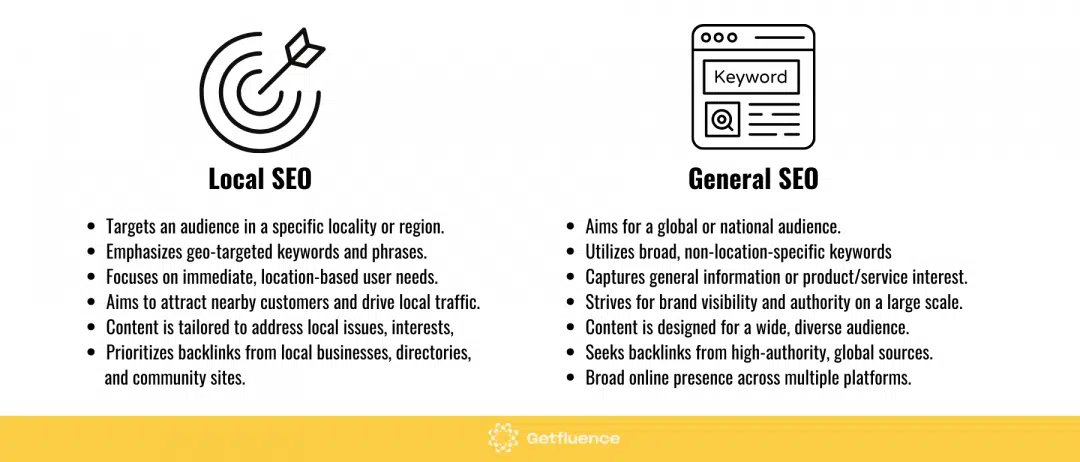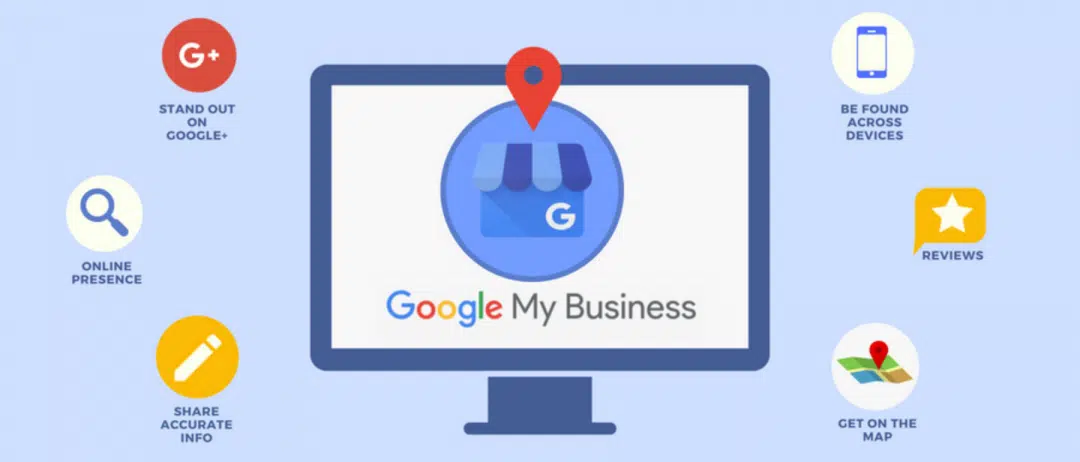- Local SEO vs. “General” SEO: spotting the differences.
- Key components of local SEO.
- SEO techniques for local optimization.
- 5 local SEO tools that work: your arsenal for local dominance.
- 5 specialized strategies in local SEO link building.
- Measuring the success of your efforts.
- Conclusion.
Imagine running a local business without a website or a local SEO strategy.
It’s akin to having a charming coffee shop in a hidden alley without a signboard; hardly anyone knows it exists.
It’s why we say that local SEO is not a trend; it’s a fundamental piece in your business’s strategy, and in how you connect with your local audience.
It’s about being seen by your community, akin to having a well-placed storefront on a busy street.
This targeted approach to search engine optimization focuses on optimizing your online presence to attract more business from relevant local searches on Google and other search engines.
For small and medium-sized businesses, local SEO is essential.
It ensures that your business appears in local searches like “best coffee shop near me” or “emergency plumbers in [your city].”
This section will explore the various facets of local SEO, from its basic principles to specific SEO techniques and link-building strategies.
We want to ensure that your business stands out to those most likely to walk through your door or request your services—people in your neighborhood or city.
Local SEO vs. “General” SEO: spotting the differences.

While local SEO and “general” SEO both aim to improve your site’s visibility in online search results, they play different games on the same field.
Local SEO: This is a laser-focused strategy tailored for businesses seeking prominence in specific geographic areas.
For instance, a restaurant in New York using “New York Italian restaurant” in its SEO efforts would likely attract local diners searching for Italian cuisine in that city.
Key to local SEO is leveraging location-based keywords, cultivating a strong reputation through online reviews, and ensuring consistent mentions across local directories.
General SEO: In contrast, general SEO adopts a broader approach, aiming to elevate a website’s visibility on a national or global scale.
It involves optimizing for non-geographically specific keywords and casting a wider net to capture a more diverse audience.
This type of SEO is ideal for businesses looking to reach a larger, more varied demographic, extending beyond local confines.
Both strategies are essential in their own right, serving different but equally important roles in a business’s overall online marketing approach.
Key components of local SEO.
1. Google My Business: more than just a pin on the map
Setting up your Google My Business profile is like planting your flag on the city map.
It’s your business’s official mark on Google’s maps and searches.
Imagine a potential customer typing in “best coffee shop near me,” and there you are—top of the list, complete with glowing reviews, photos, and all the essential details.
Keeping this profile updated and rich with information is like keeping the lights on and the door open for your digital customers.

And this process is more than just marking your location; it involves:
- Ensuring Accuracy: Confirming that your business name, address, and phone number are consistent and correct
- Describing Your Business: Adding a Clear Description and Selecting the Right Category
- Engaging with Reviews: Actively responding to customer reviews to build a positive reputation
- Implementing Google Posts to share updates, offers, or events will keep your profile active and engaging.
- Showcasing Offerings: Listing your products and services directly on your profile
- Utilizing the Q&A feature of Google My Business to address common customer inquiries
- Maintaining Accurate Hours: Keeping your business hours updated, especially during special events or holidays,
2. Localized content and keywords: Crafting a rich local digital identity
Embracing local SEO is like dialing into your community’s unique frequency. Start by optimizing your web content with local terms that resonate with potential customers.
Use tools like Semrush to find geo-specific keywords; for instance, a New York-based family lawyer should target phrases like “NY family attorney” to optimize their service pages.
- Keyword research: use tools like Google Keyword Planner and SEMrush to identify high-impact local phrases.
- Keyword Integration: Begin by integrating local keywords into your content. This includes using terms your local audience searches for.
- Website Optimization: Incorporate these keywords thoughtfully in URLs, title tags, and meta descriptions. Also, use structured headings and internal links.
- Optimize your website’s loading speed and mobile responsiveness, as local searches are predominantly performed on mobile devices.
3. Creating a local identity with your contact page
Your contact page is a cornerstone of your local SEO. It should feature your business name, local address, hours, and detailed contact information, along with an embedded map.
This page isn’t just for information; it signals your business’s authenticity and location to Google.
Generally, remember:
- Ensure your NAP (name, address, and phone number) details are consistent across your website and all online directories.
- Detail-Rich Information: Your contact page should feature comprehensive details, including your business name, local address, and hours.
- Authenticity Signal: A well-optimized contact page not only aids users but also signals your business’s authenticity to search engines.
- Embed a Google Map on your contact page to enhance local search signals.
- Use schema markup for local businesses on your contact page to help search engines better understand and display your local information.
SEO techniques for local optimization.
When you’re launching your local business, understanding and mastering local keyword research and integration is akin to unlocking a treasure chest of digital opportunities.

Here’s a detailed guide to help you navigate through this aspect:
Step 1: dive into local keyword research.
Local keyword research is about comprehending how people in your area search for the services you offer.
Begin by listing the services your business provides, as these form the foundation of your keyword strategy.
Use these service keywords as seeds to discover more specific terms that people are searching for in your area, such as “gas boiler installation” or “electric boiler installation.
Let’s make a list.
- Identify Services: List all services and products your business offers. E.g., for a dental clinic, this might include ‘teeth whitening’, ‘orthodontics’, etc.
- Utilize Tools: Use keyword research tools like Google’s Keyword Planner, SEMrush, or Ahrefs to find local-specific keywords.
- Analyze Search Intent: Understand why local customers are searching for these services. Are they seeking information, looking to purchase, or comparing options?
- Competitor Analysis: Review your competitors’ websites and their keyword strategies to identify gaps and opportunities.
- Regularly update your keyword list based on trends and local events.
Step 2: Optimize website content with local keywords.

Optimizing your website with local keywords is essential for connecting with your local audience.
This step ensures your website content is tailored to meet the specific needs and interests of your local market.
Let’s see the detailed steps:
- Integrate Keywords Naturally: Incorporate local keywords into your website’s content, headers, and meta descriptions.
- Create Localized Content: Publish blog posts, case studies, or guides that address local issues or topics.
- Optimize for ‘Near Me’ Searches: Include phrases like “near me” or local landmarks in your content.
- Structured Data Markup: Use schema markup to highlight local information on your website.
- Local Landing Pages: If you serve multiple areas, create dedicated pages for each location with specific local content.
Step 3: Local SEO Link Building Strategies.
Yes, we need to implement a link building strategy for local SEO, because it is about forging connections that establish your website’s authority within a local context.
It will help you improve your visibility in local search results.
- Engage with Local Communities: Participate in local events and forums to gain visibility.
- Generate Local Press: Engage with local media and bloggers for potential features and mentions.
5 local SEO tools that work: your arsenal for local dominance.
When you start your local SEO strategy, having the right tools can make all the difference.
Here are five formidable tools that stand out in the quest for local search supremacy:
1. GrowthBar.
GrowthBar shines as a multifaceted SEO tool, offering a wealth of features right from your Google browser.
Its Chrome extension is a treasure trove for local SEO insights, allowing you to conduct keyword research, analyze backlinks, and even delve into PPC analysis without leaving your browser.
GrowthBar’s unique selling point lies in its ability to uncover local keyword suggestions and identify your competitors’ top-performing keywords, giving you a strategic edge in local search rankings.
2. Serpstat Local SEO.
Serpstat’s Local SEO tool is your one-stop solution for managing your business’s online presence and reputation across numerous local directories.
It streamlines the process of syncing your business information across platforms like Google Maps, Facebook, TripAdvisor, and Yelp.
With features like location profile editing, data synchronization, and statistical analysis, Serpstat ensures that your business information is consistent and up-to-date, enhancing your local SEO performance.
3. Whitespark.
Founded by local SEO expert Darren Shaw, Whitespark offers a suite of tools designed to bolster your local search marketing efforts.
Its Local Citation Finder helps unearth critical citation opportunities, while the Local Rank Tracker monitors your local and organic search performance.
Whitespark’s Reputation Builder and Link Prospector tools further empower businesses to earn reviews and discover new link-building opportunities.
These comprehensive features help you increase your local search rankings, manage your reputation, and ultimately attract more customers.
4. Uberall.
Uberall stands out as a comprehensive local marketing platform designed to enhance your business’s online presence across multiple directories and platforms.
It specializes in helping businesses manage their digital footprint across various channels, ensuring consistency in NAP (name, address, and phone number) information, and enhancing local search visibility.
Uberall’s platform is particularly useful for businesses with multiple locations, providing tools to manage and optimize each location’s online presence effectively.
5. Moz Local.
Moz Local is a highly effective tool for managing local listings and enhancing your business’s online presence.
It excels at ensuring that your business listings are consistent and accurate across various online directories.
Moz Local also helps in monitoring and responding to customer reviews, which is vital for maintaining a positive online reputation.
Its user-friendly interface and comprehensive features make it a go-to tool for businesses aiming to improve their local search engine rankings and online visibility.
5 specialized strategies in local SEO link building.
1. Enhancing credibility through strategic local connections.
SEO link building goes beyond mere online visibility, and it is a strategic effort to embed your business within the local digital ecosystem.
This involves actively seeking opportunities to get your business linked to reputable local websites, news portals, and community blogs.
These local backlinks are hyperlinks, digital affirmations of your business’s standing and authority within the local community.
2. Leveraging Getfluence for local link building.

A powerful strategy for acquiring these valuable local backlinks is through sponsored content, and this is where Getfluence comes into play.
Getfluence connects businesses with influential local (and international) media outlets, offering an efficient way to create and distribute content that not only resonates with the local audience but also provides high-quality backlinks to your site.
This sponsored content approach allows for targeted exposure, helping to amplify your local presence and SEO efforts.
3. Building local partnerships.
Collaborating with other local businesses for joint promotions or events can result in reciprocal online features, enhancing your web of local connections.
Establishing partnerships with local businesses not only strengthens community ties but also opens avenues for natural, mutually beneficial backlink opportunities.
4. Local media engagement and community participation.
Engaging with local media through features, interviews, or stories about your business’s involvement in community events can lead to significant backlinks.
This approach not only boosts your local SEO but also builds your reputation as an active community player.
5. Directory listings and content creation.
Ensure your business is listed in local directories, which are often deemed authoritative by search engines.
Additionally, creating localized content like blog posts about local happenings or guides offers value to your community, increasing the likelihood of being linked by local websites and blogs.
Measuring the success of your efforts.
Imagine your local SEO efforts as a garden you’ve nurtured; now it’s time to see how well it’s blooming.
Dig into the data soil and see how your efforts are taking root in the local digital ecosystem.
Metrics: Your SEO tools.
- Google Analytics: It’s like your digital detective, uncovering where visitors are coming from and how they interact with your site. Keep an eye on those local visitors; they’re your main guests.
- Google My Business Insights: This tool is like your local popularity meter. It reveals how customers find your listing and interact with it—are they calling, asking for directions, or just browsing?
- Rank Tracking Tools: Tools like Moz Local act as your local SEO scoreboard, showing where you stand in the local search rankings game.
- Conversion Metrics: Are those local searches turning into calls, bookings, or sales? That’s your direct ROI right there.
- Customer Reviews and Interactions: The reviews and active engagement signal a strong local presence and reputation.
Conclusion.
As we draw our exploration of local SEO to a close, it’s evident that mastering this domain it’s about laying the foundation for sustainable growth.
Local SEO is a dynamic work, one that evolves with technology and local consumer behaviors.
Stay ahead in this world and try to consider these future-focused strategies:
- Embrace Emerging Technologies: Stay abreast of evolving tech, like voice search and AI, which are reshaping local search dynamics. Optimize your content for voice queries and invest in AI-driven tools to analyze local search trends.
- Focus on Hyperlocal Content: As search engines become more sophisticated, hyperlocal content will gain prominence. Tailor your content to address ultra-local issues or events, offering a personalized experience to your audience.
- Engage in Community-Driven SEO: Build partnerships with local influencers and participate in community projects. This not only boosts your local presence but also cements your business as a community-centric brand.
- Monitor and Adapt: Use analytics to continually monitor your local SEO performance. Be ready to adapt your strategies based on what the data reveals about your local audience’s preferences and behaviors.
- Educate and Empower Your Team: Ensure your team understands the nuances of local SEO. Regular training and workshops can empower them to contribute effectively to your local SEO efforts.
Remember, local SEO it’s a commitment to grow alongside your community, understanding its pulse and meeting its needs.
If you stay informed, adaptable, and deeply connected with your local audience, your business is not just a name in the search results; it will become a trusted part of the local landscape.





